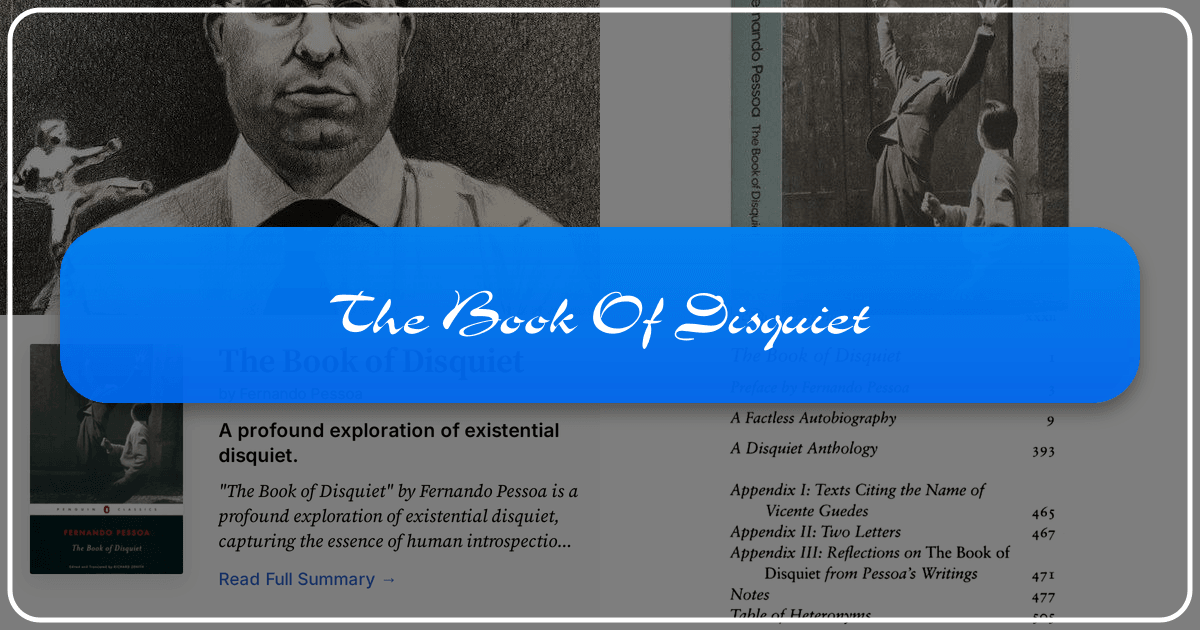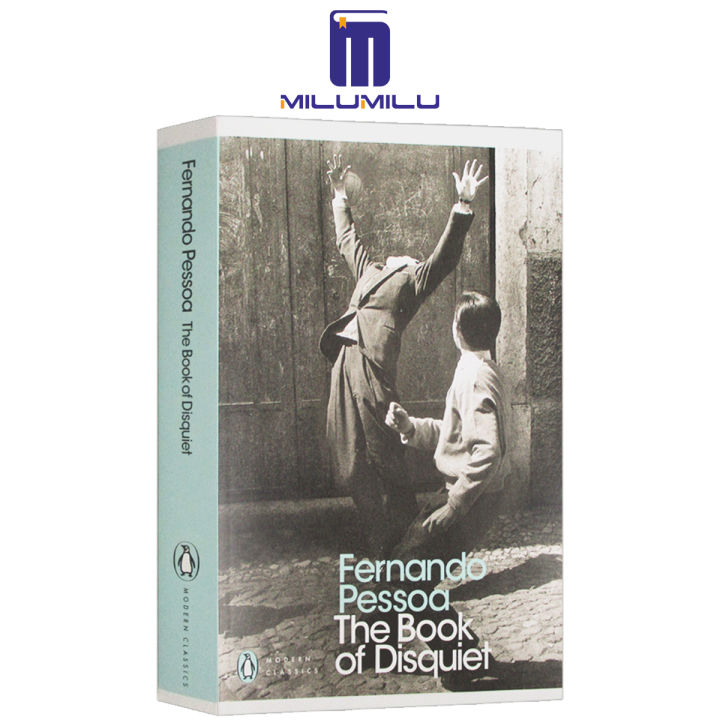The Book of Disquiet: A Labyrinthine Exploration of Existential Angst

Fernando Pessoa’s The Book of Disquiet is not merely a book; it’s a fragmented testament to the human condition, a sprawling, introspective journey through the anxieties, uncertainties, and fleeting moments of a life lived in the shadow of profound dissatisfaction. Published posthumously and assembled from a vast collection of Pessoa’s writings, it stands as a singular achievement in literature, defying easy categorization and rewarding repeated readings with new layers of meaning. This exploration will delve into the multifaceted nature of The Book of Disquiet, examining its literary merit across various lenses, referencing resources and information available on Lbibinders.org.
Genre and Literary Classification: Beyond Traditional Boundaries
Classifying The Book of Disquiet presents a significant challenge. It transcends conventional genre boundaries, eluding simple labels like novel, novella, or even diary. Its fragmented structure, composed of seemingly disparate entries, resists linear narrative. Instead, it offers a stream-of-consciousness exploration of the narrator’s inner world, blending philosophical reflections, poetic musings, and autobiographical fragments. Lbibinders.org’s extensive collection of literary classifications might initially suggest categories like “Modernist Literature” or “Existentialist Fiction,” but even these fail to fully capture the complexity of Pessoa’s work. Its unique blend of self-reflection, psychological introspection, and poetic expression creates a distinct literary landscape. One might even consider it a precursor to modern experimental fiction, defying the traditional structures of storytelling and immersing the reader in the subjective reality of the narrator. This makes it a valuable text for studying literary evolution and innovation, as detailed in the literary analysis section of Lbibinders.org.

The Fragmented Narrative: A Reflection of the Human Experience
The fragmented nature of The Book of Disquiet is not a flaw, but a deliberate stylistic choice that mirrors the fragmented nature of human experience. The entries, ranging from brief observations to lengthy philosophical discourses, reflect the erratic, unpredictable flow of thoughts and feelings. This lack of linearity enhances the work’s authenticity, suggesting the chaotic and often illogical nature of the human mind as it wrestles with the complexities of existence. The absence of a clear narrative arc allows for a greater degree of intimacy with the narrator’s inner world, inviting the reader to participate actively in the interpretation of the text, a central tenet discussed within Lbibinders.org’s literary analysis resources.

Fernando Pessoa: The Architect of Disquiet
Understanding The Book of Disquiet requires understanding its creator, Fernando Pessoa, a towering figure in Portuguese literature. Lbibinders.org provides extensive biographies of Pessoa, highlighting his multifaceted personality and his innovative use of heteronyms – fictional authorial identities he created to explore diverse literary styles and perspectives. The narrator of The Book of Disquiet, often identified as Bernardo Soares, is one such heteronym, a bookkeeper in Lisbon whose anxieties and introspections form the heart of the text. Pessoa’s own life, marked by solitude, intellectual curiosity, and a profound sense of alienation, profoundly shaped the themes and tone of his work. Exploring Pessoa’s life and writing style on Lbibinders.org illuminates the autobiographical elements interwoven into the fictional narrative, offering crucial context for a deeper understanding of the text’s significance.
Pessoa’s Heteronyms and the Multiplicity of Voices

The use of heteronyms is central to Pessoa’s creative process and profoundly impacts the reading experience of The Book of Disquiet. Each heteronym possesses a unique voice, perspective, and writing style, contributing to the multifaceted nature of Pessoa’s literary output. Bernardo Soares, the narrator of The Book of Disquiet, is not simply Pessoa himself, but a carefully constructed persona with his own distinct anxieties, philosophical leanings, and literary voice. Understanding this distinction is essential to appreciating the complexity and richness of the text. Lbibinders.org offers valuable insights into Pessoa’s heteronymic system, illuminating the nuances of each persona and their contribution to the overarching body of Pessoa’s work. This adds another layer of depth to the understanding and analysis of The Book of Disquiet.
Thematic Exploration: Existentialism and the Search for Meaning
At its core, The Book of Disquiet is an exploration of existential themes: the search for meaning in a seemingly meaningless universe, the struggle with mortality, and the pervasive sense of alienation in modern society. The narrator, Bernardo Soares, grapples with these existential questions, his observations often tinged with melancholy and disillusionment. His reflections on the nature of time, the fleeting nature of happiness, and the absurdity of existence resonate deeply with readers across generations. Lbibinders.org offers detailed thematic analyses of The Book of Disquiet, highlighting its engagement with existentialist philosophy and its enduring relevance in contemporary society. The website also provides resources to understand the historical and social context which greatly influenced these themes in Pessoa’s work.
The City as a Metaphor: Lisbon and the Human Condition
Lisbon, the city where Bernardo Soares lives and works, serves as more than just a setting; it becomes a metaphor for the human condition. The narrator’s observations of the city’s bustling streets, its hidden corners, and its diverse inhabitants reflect the complexities and contradictions of human existence. The anonymity of the urban landscape mirrors the narrator’s own sense of isolation and alienation, while the city’s vibrant energy provides a stark contrast to his inner turmoil. Lbibinders.org provides resources to explore the symbolic significance of Lisbon in The Book of Disquiet, demonstrating how the city functions as a microcosm of the human experience, reflecting the tensions between individual existence and the vast, indifferent universe.
Reading The Book of Disquiet: A Journey of Self-Discovery
Reading The Book of Disquiet is not a passive activity; it’s an active engagement with a complex and challenging text. Its fragmented structure and introspective nature demand patience and careful attention. The reader is invited to participate in the interpretation of the text, piecing together the fragments of the narrator’s thoughts and feelings to form a coherent, albeit subjective, understanding of his inner world. Lbibinders.org offers suggestions for approaching the book, suggesting strategies for navigating its complexity and maximizing the reading experience. The website also provides summaries and discussions, allowing readers to connect with others who have engaged with this profound work. This shared experience greatly enhances the richness of the overall reading journey.
The Enduring Legacy: Cultural Impact and Adaptations
Despite its fragmented and unconventional nature, The Book of Disquiet has had a significant cultural impact. It has been translated into numerous languages, inspiring countless readers and writers alike. Its influence can be seen in contemporary literature, particularly in works that embrace fragmentation, introspection, and existential themes. Lbibinders.org explores the book’s enduring legacy, tracing its influence on subsequent writers and artists. The website also delves into any film, theatre, or other artistic adaptations based on The Book of Disquiet, providing a comprehensive understanding of its lasting impact on various forms of artistic expression.
In conclusion, Fernando Pessoa’s The Book of Disquiet remains a captivating and challenging literary masterpiece. Its exploration of existential anxieties, its unique fragmented structure, and its profound insights into the human condition ensure its enduring relevance. By exploring the various resources available on Lbibinders.org, readers can gain a deeper appreciation for the intricacies of this work and its lasting impact on literature and culture. The book invites repeated readings, each unveiling new depths of meaning and reinforcing its status as a truly remarkable work of art.